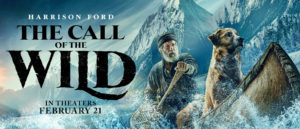 By Steve Crum
By Steve Crum
If The Call of the Wild often looks like a live action cartoon, there is good reason for it. The sled dogs, including the lead dog and film’s star, Buck, are indeed animated. (Buck’s backstory later.) Rest assured that their computer generated images are for the most part impossible to separate from the real thing. The CGI Klondike exteriors also appear remarkably real, even though the film was not shot on location in Alaska.
It turns out that The Call of the Wild is a very good action-adventure film based upon Jack London’s endearing 1903 novel. Although its PG rating is based upon some violence and peril depicted, the film is ultra suitable for family audiences.
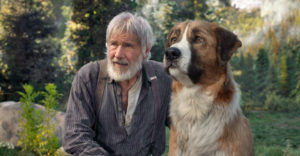 Harrison Ford stars as John Thornton, a bedraggled, white bearded prospector living in 1900 Skagway, Alaska, per se gateway to The Yukon and gold seekers. Ford also infrequently narrates. He does fine on both counts, particularly when displaying kind and protective love toward his canine companion, Buck.
Harrison Ford stars as John Thornton, a bedraggled, white bearded prospector living in 1900 Skagway, Alaska, per se gateway to The Yukon and gold seekers. Ford also infrequently narrates. He does fine on both counts, particularly when displaying kind and protective love toward his canine companion, Buck.
The film serves as the live-action directorial debut of Chris Sanders—of the animated How To Train Your Dragon fame. Adapting London’s novel is Michael Green.
 Another first for this movie is the opening logo. The decades old 20th Century Fox Fanfare is heard, along with the familiar searchlights. But the “Fox” is forever gone, replaced by “Studios.” Henceforth, it will be “20th Century Studios.”
Another first for this movie is the opening logo. The decades old 20th Century Fox Fanfare is heard, along with the familiar searchlights. But the “Fox” is forever gone, replaced by “Studios.” Henceforth, it will be “20th Century Studios.”
The movie’s premise involves a lovable adult St. Bernard/Scotch Collie dog, Buck, who we see at the opening as the clumsily destructive family pet of an upper class family in Santa Clara, California. Buck is dognapped and sent with freight haulers to Alaska. Top dollar is paid for dogs there since snow sleds require canines as team pullers. What Buck lacks in Husky dog prowess, he makes up for in stamina and intelligence. He can also be vicious in self defense.
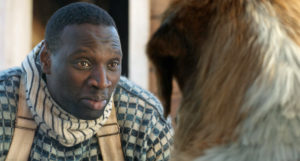 And he is loyal to his friends, both dogs and humans. Enter John Thornton, who befriends Buck after he helps the dog escape from cruel captors. At first, Buck’s life in the snow and ice includes multiple masters and mishaps after being force trained to work with a dog team. Actors Dan Stevens, Omar Sy, Karen Gillan, Bradley Whitford, and Colin Woodell round out a cast that crosses tracks with the once incorrigible Buck.
And he is loyal to his friends, both dogs and humans. Enter John Thornton, who befriends Buck after he helps the dog escape from cruel captors. At first, Buck’s life in the snow and ice includes multiple masters and mishaps after being force trained to work with a dog team. Actors Dan Stevens, Omar Sy, Karen Gillan, Bradley Whitford, and Colin Woodell round out a cast that crosses tracks with the once incorrigible Buck.
As the story proceeds, Buck also confronts a bear and wolves—emphasis on the latter. All are CGI’d. It is with them that Buck plays out the film’s title. Speaking of the title, which retains Jack London’s, this story has been told on screen multiple times in both full animation and live action. There was even a best selling Classics Illustrated comic book adaptation. Charlton Heston had a go at the Thornton 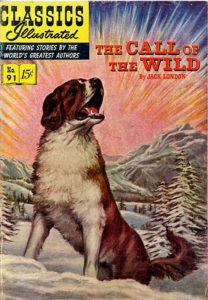 character in 1972 as did Clark Gable (1935). Sadly, Gable’s version, directed by William Wellman, only uses Buck’s story as secondary to a love story involving Thornton.
character in 1972 as did Clark Gable (1935). Sadly, Gable’s version, directed by William Wellman, only uses Buck’s story as secondary to a love story involving Thornton.
However, this 2020 take is much closer cloning to London’s novel in that Buck is THE central character. Thanks to CGI, we can almost read his mind via body language and facial expressions. That goes for the other animals as well. They convey thoughts and emotions through subtle pantomime. Still, I was at times convinced Buck and his cronies WERE real. It is an amazing technical accomplishment recently used in Disney’s The Jungle Book (2016) and The Lion King (2019).
——-
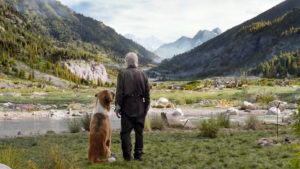 As postscript, the CGI model for Buck is also named Buck—for Buckley. Seeking to find the perfect model for Buck, the film’s production team met success via a stray St. Bernard housed at an animal shelter in Emporia, Kansas. The cool capper is that director Chris Sanders and his wife, Jessica, then lovingly adopted Buck as their own.
As postscript, the CGI model for Buck is also named Buck—for Buckley. Seeking to find the perfect model for Buck, the film’s production team met success via a stray St. Bernard housed at an animal shelter in Emporia, Kansas. The cool capper is that director Chris Sanders and his wife, Jessica, then lovingly adopted Buck as their own.
A happy ending.
=====
GRADE, On A to F Scale: A-
